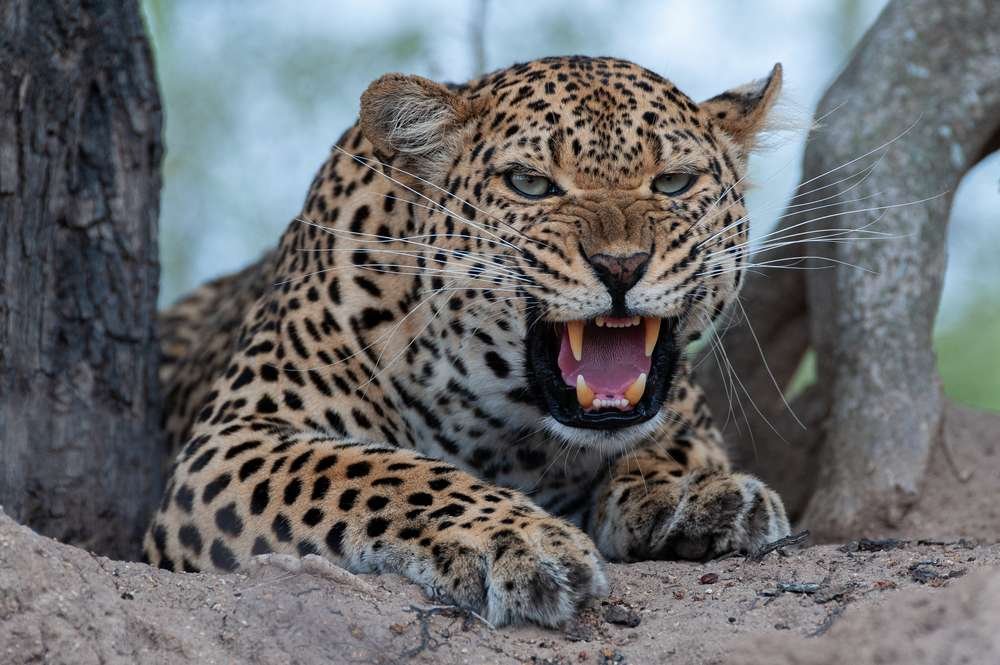African Leopard
( Imbwili (bemba) )
- Panthera pardus pardus
- IUCN Status: Vulnerable
- Trend: decreasing

- Kingdom: Animalia
- Phylum: Chordata
- Class: Mammalia
- Order: Carnivora
- Suborder: Feliformia
- Family: Felidae
- Subfamily: Pantherinae
- Genus: Panthera
Share:
General Information
African Leopards are shrew, secretive and elusive predators that mostly hunt solo and can kill prey larger in size. They have powerful jaws that enable them to kill and dismember prey and their long sensitive whiskers allow them to ‘feel’ their way as they hunt at night. Leopards are very agile climbers, with heavily-muscled shoulders and forelimbs which enable them to haul their prey high up into trees, keeping it safe from scavengers.
Fun Facts!
African leopards are one of the best stalkers in the animal kingdom. They are incredibly stealthy and patient, and they can use their camouflage to blend in with their surroundings. Leopards are also very good at reading their prey’s body language, which allows them to anticipate their next move.. They can see seven times better than humans in the dark. On top of having fast speeds nearing 60 kilometers per hour, you’ll be surprised to learn that leopards can leap up to 6 meters forward (that’s horizontal distance, not vertical, by the way!)
Description
- Shoulder height: 45 – 80 cm
- Length: 100 – 190 cm
- Weight: 60-70 kg
- Lifespan: 10 to 19 years
Ecology and Behaviour
African leopards are the most solitary large cats. Young stay with their mothers until they become independent at about 22 months. Male leopards are solitary and territorial, with their home ranges varying due to prey availability and the type of habitat they live in. They are nocturnal, spending the day sleeping in dense bushes or draped over a tree limb and they are active, hunting at night. Due to their acute hearing and vision and their ability to move silently. They can stalk without being detected, then pounce on a wide variety of prey, from reptiles and fish to small birds and medium-sized antelopes. They are strong, agile climbers, storing their kills in trees, hiding them from other large predators.
Conservation
African Leopards have been classified as vulnerable though mostly “near threatened”. Their wide ranging diet and ability to utilize many different habitats means that they have been able to survive the threats of decreasing habitats far better than other large cats.
Distribution and Habitat
African Leopards rarely meet with each other, instead they communicate through scent marking along commonly used routes and their boundaries. They vocalize by ‘rasping’, which sounds like someone sawing through wood. They also grunt when alarmed, and snarl, growl and hiss when enraged. The white tip on their tail acts as a ‘follow me’ signal between mothers and their cubs.
Females give birth to a litter of two or three cubs after a gestation period of about 100 days in dense undergrowth. Cubs then venture out into the open at six weeks and are weaned after three months. They stay with their mother until they are almost two years old, learning to hunt and pounce on a variety of objects through play.
Leopards can adapt to live in almost any habitat, and can be found in deserts, rocky hills, mountains, lowland forests, woodland, grasslands and in swamps.
Despite their size, leopards are vulnerable to other predators and when a mother is hunting, her cubs are defenseless from being killed by lions, hyenas, wild dogs, snakes and birds of prey.
Interaction with humans
Humans have long posed a serious threat to these majestic creatures. Threats which may include habitat loss, human wildlife conflict and the illegal trade in skins and teeth for traditional medicines.
No donation to this project yet.
| M | T | W | T | F | S | S |
|---|---|---|---|---|---|---|
| 1 | 2 | 3 | 4 | 5 | 6 | 7 |
| 8 | 9 | 10 | 11 | 12 | 13 | 14 |
| 15 | 16 | 17 | 18 | 19 | 20 | 21 |
| 22 | 23 | 24 | 25 | 26 | 27 | 28 |
| 29 | 30 | 31 | ||||


